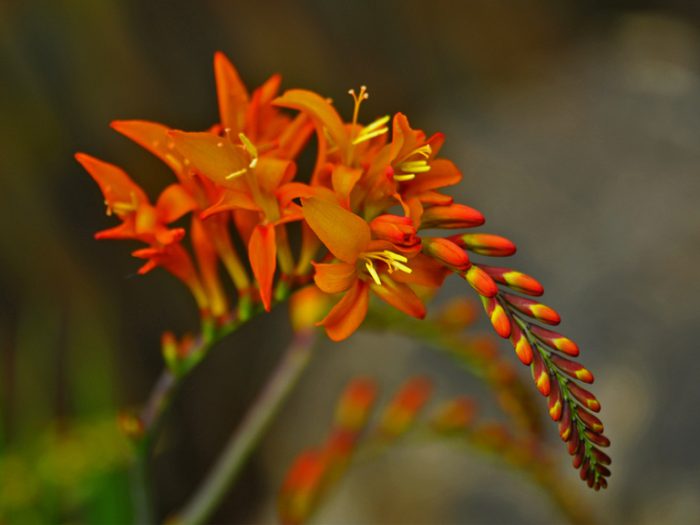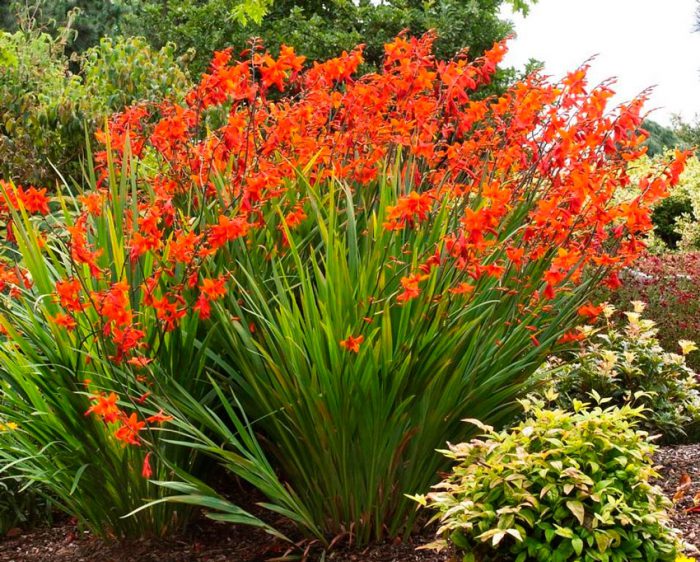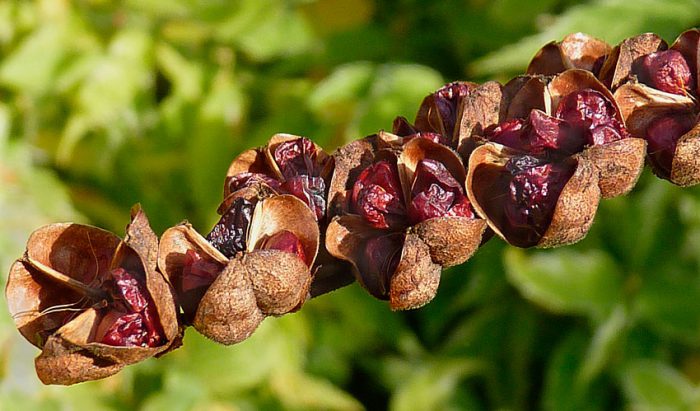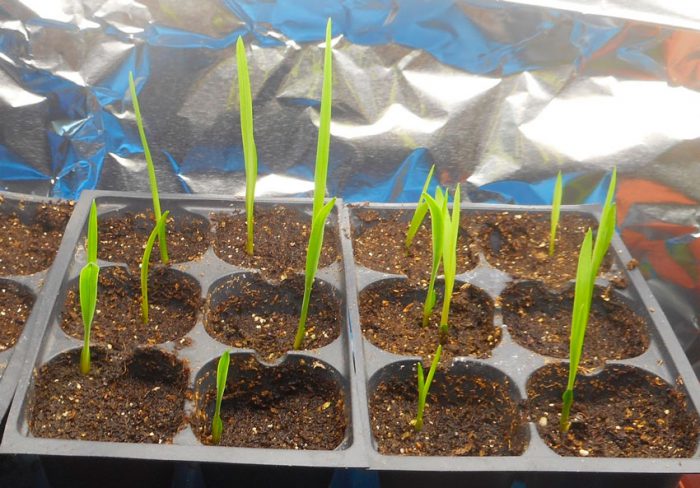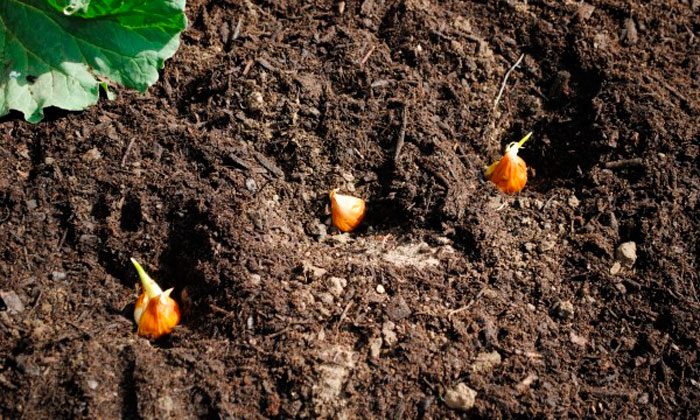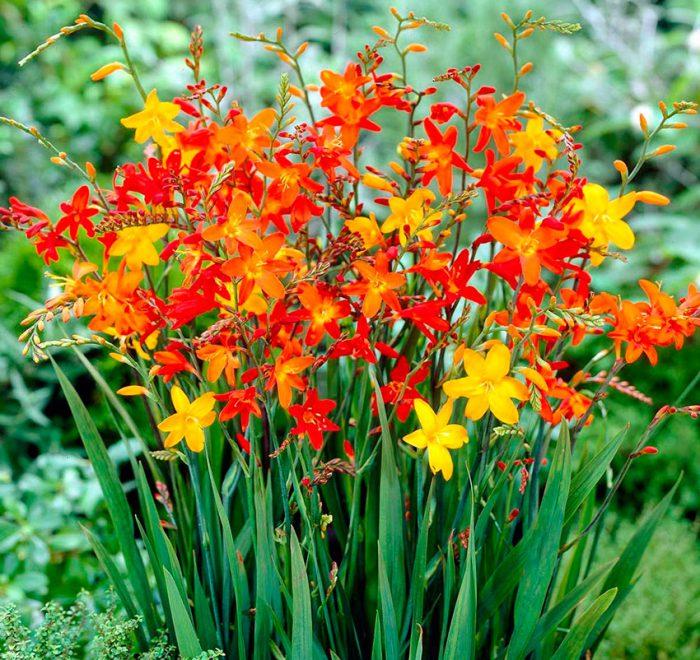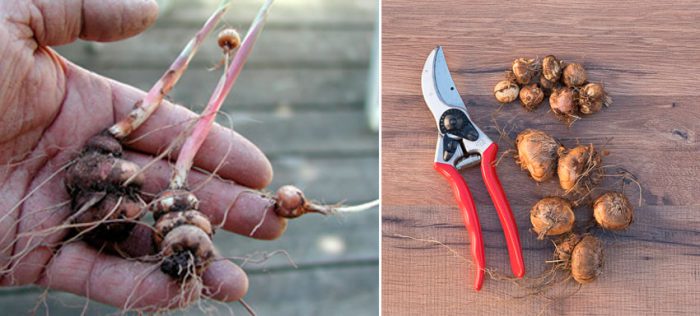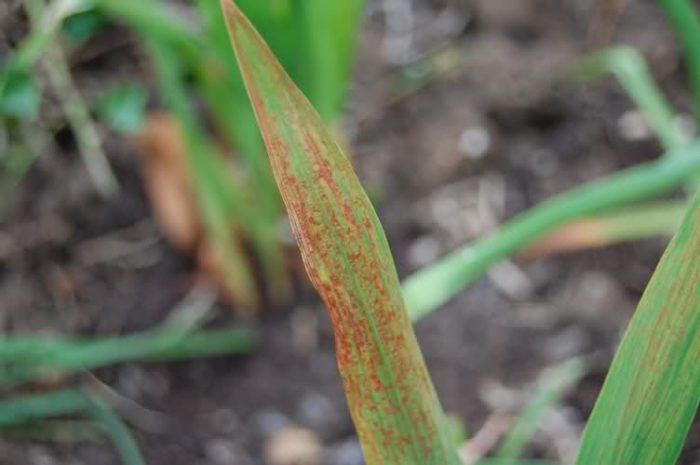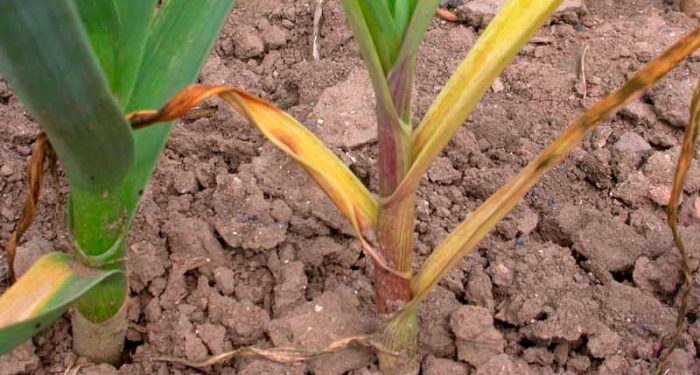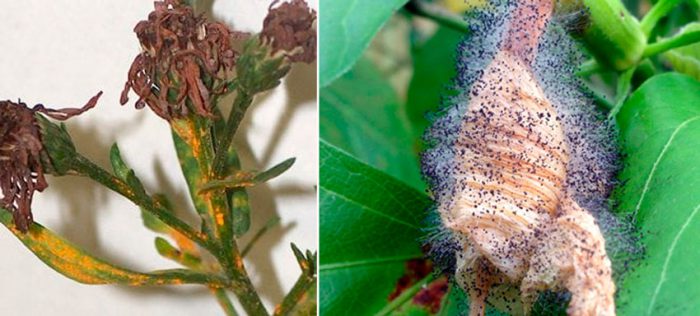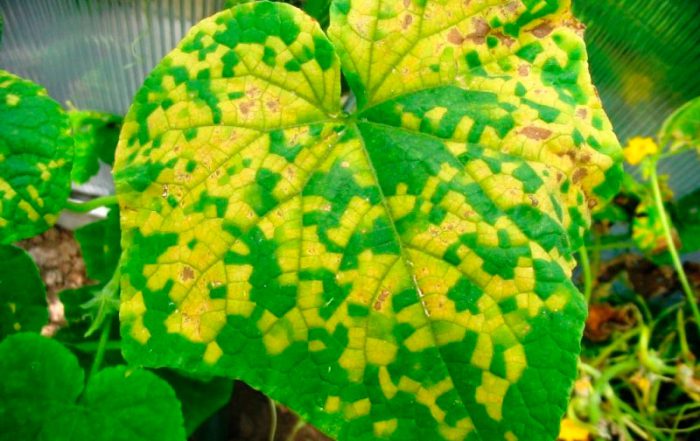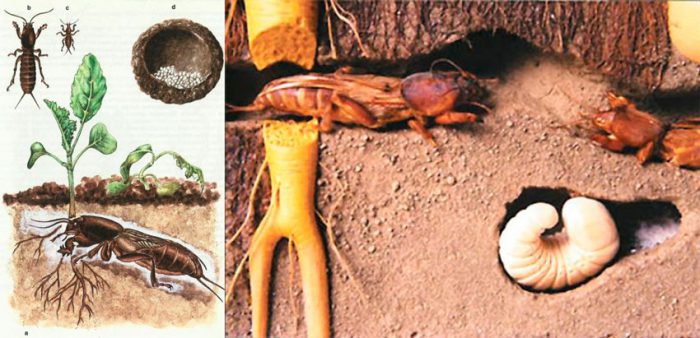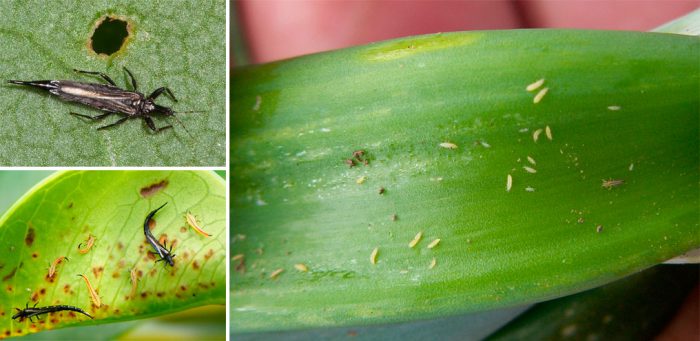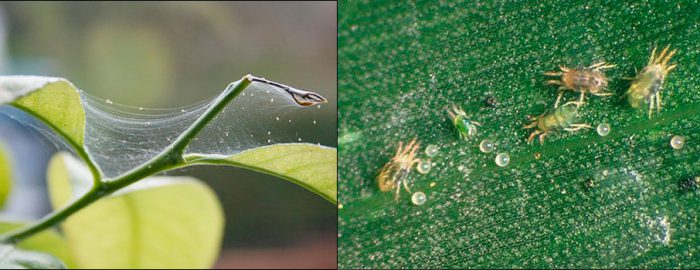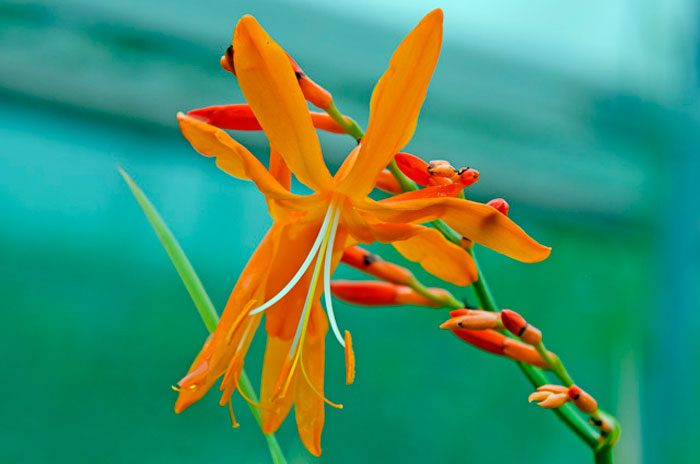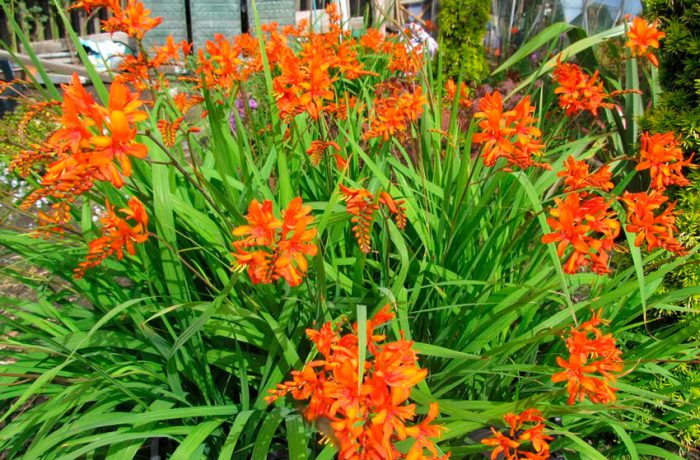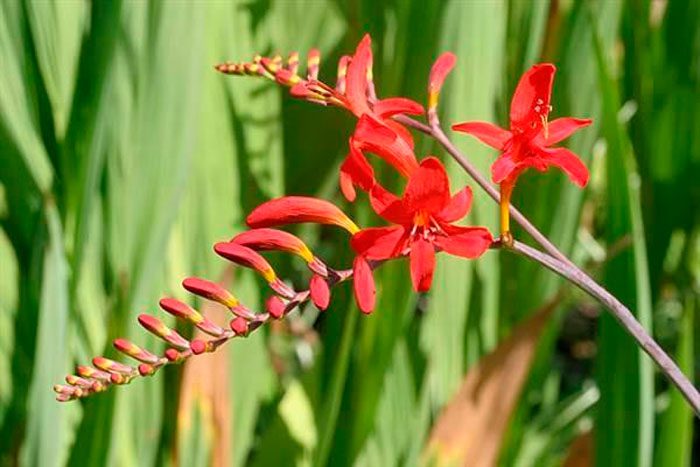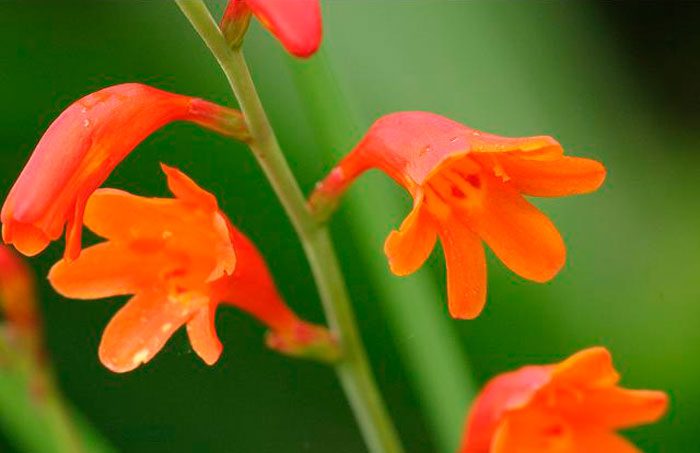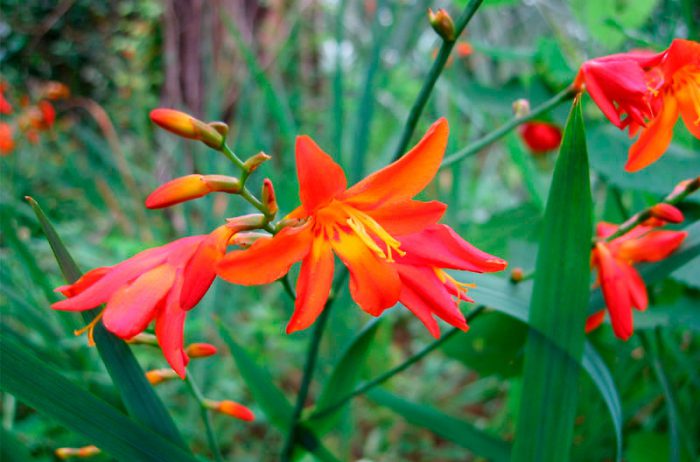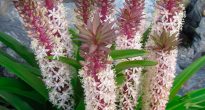Crocosmia (Crocosmia), or montbrecia (outdated name), or tritonia is a bulbous plant belonging to the iris family. Crocosmia consists of 2 Greek words: "kroros" - "crocus" and "osme" - "smell". The fact is that dried crocosmia flowers have a smell similar to that of saffron (crocus). And this plant was named Montbrecia in honor of the Frenchman Antoine François Ernest Cockbert de Montbre, who was a botanist. Tritonia is translated from Greek as "weather vane", this plant is so called because of the inflorescence, which has a spreading shape. In natural conditions, such a flower can be found in southern Africa. In European countries, this plant has been cultivated since the 19th century.
Content
Features of crocosmia
To date, cultural crocosmia is a bulbous herbaceous hybrid perennial, which is called common crocosmia. This hybrid was created by Lemoine in the 19th century, crossing the golden crocosmia and Potts crocosmia. The surface of the small tuber is covered with a reticular membrane. The height of this plant can vary from 0.4 to 1 meter. It has a branching stem, on which leaf plates of a xiphoid or linear shape are located. There is also a very strong peduncle, which makes the plant look like gladiolus. In this regard, crocosmia is also called "Japanese gladiolus", while it must be grown in the same way as the gladiolus itself. The star-shaped flowers are colored white, orange and yellow, and they can be up to 5 centimeters in diameter. Dense paniculate inflorescences consist of 3-5 flowers. The fruit is a polyspermous round box.
This plant is very closely related to popular flower crops such as iris, gladiolus, crocus saffron, ferraria and freesia. Crocosmia is most often used to decorate open flower beds, growing together with plants such as canna, salvia, daylily, rudbeckia and echinacea. This flower is also suitable for cutting, so its inflorescences can stand in water for up to a half moon.
Below will be described in detail how to plant and grow crocosmia.And also a lot of useful and just very interesting information about this plant will be given.
Growing crocosmia from seeds
Sowing
For reproduction of crocosmia, you can use seeds or corms. If you decide to start growing from seeds, then the choice should be stopped on the seedling method. The fact is that when sowing seeds in open soil, you can not wait for shoots. Sowing should be done in the last days of February or the first in March. Immediately before sowing, the seeds must be poured with water for 24 hours, while it should be replaced every 6 hours. Then the seeds are sown into a soil mixture, which includes peat, sand, turf and humus. Then the container should be covered with foil and rearranged in a well-lit place.
Seedling
You need to take care of crocosmia seedlings in almost the same way as for other flower crops. After the first seedlings appear, the shelter should be removed. Watering should be done as the upper layer of the substrate dries up, and it will also be necessary to systematically carefully loosen its surface to a shallow depth. Try to choose such a watering regime so that the substrate is slightly damp all the time, but water does not stagnate in the soil, as this can contribute to the development of a fungal disease.
Picking
When the second or third real leaf appears at the plants, they will need to be dived into separate pots. They will grow in them until they are transplanted into the garden. Half a month before planting the plants in open soil, they will need to be hardened. To do this, they need to be briefly transferred to fresh air, while the procedure should become longer and longer every day.
Planting crocosmia in open ground
What time to plant
Transplanting seedlings into open soil should be done in the last days of April or the first in May, while the earth should warm up to 6-10 degrees. In order to see the bloom of crocosmia, it should be planted in an open, well-lit area, otherwise flowers may not appear on it at all. The soil must necessarily be permeable, while the groundwater in the place where the plant is grown should not lie too close to the surface of the earth. The fact is that these flowers react extremely negatively to stagnant fluid in the root system. The landing site must be prepared in the autumn. To do this, you need to dig up the soil, while for every 1 m2 add a couple of buckets of humus, 40 grams of superphosphate, 100 grams of slaked lime and 20 grams of potassium chloride. In spring, before planting crocosmia, nitrogen-containing fertilizers must be added to the soil with obligatory incorporation (30 grams of substance per square meter).
How to plant
Seedlings should be planted in pre-prepared holes, while taking into account that the distance between the bushes should be from 10 to 12 centimeters, and the row spacing should be from 25 to 30 centimeters. When the seedlings are planted, they should be watered. For the first two or three days, she will need shelter from the scorching rays of the sun. Such a plant, obtained from a seed, will begin to bloom only after 3 years from the moment of germination. However, if optimal conditions are provided for him, then it will be possible to admire his beautiful flowers in just 2 years.
Crocosmia care in the garden
You need to take care of crocosmia in almost the same way as for gladioli. Watering should be abundant and carried out every 7 days. When the water is absorbed into the soil, it is recommended to loosen it to break up the crust that has appeared.
For normal growth and development, such a flower must be systematically fed. In the event that you planted crocosmia on nutrient-rich soil, then you can do without top dressing.But in the event that the soil is poor, then you need to start feeding the plants after the second true leaf is formed, while such a procedure is carried out with a frequency of 1 time in 1.5 weeks. To do this, it is recommended to use an infusion of mullein (1 part of mullein is taken for 10 parts of water), as well as a complete mineral fertilizer (for a liter of water, 2 grams of the product). During budding, such a plant needs a fertilizer containing a large amount of potassium.
Taking care of crocosmia is not at all difficult. As for diseases and pests, if you follow all the rules of agricultural technology, you will not have problems with this plant.
How to propagate
It has already been said above that such a flower can be propagated by seeds, and also for this they use a vegetative method. You can read about how to grow crocosmia from seeds above. For vegetative propagation, gardeners use the division of corms. Each year, about one adult corm grows up to 5 children, which begin to bloom next year. At the same time, the parental corm continues to grow children. In this regard, when growing such a flower, it should be borne in mind that it will be systematically necessary to divide and plant the corms.
Division is usually done after the planting becomes very dense. To do this, in the spring, you need to dig out the corms and carefully tear off the children from the parent bulb, which are then planted in a permanent place. At the same time, it is recommended to plant children in the same time period as planting seedlings, namely, in the last days of April or the first days of May. If there is a desire, then for a start, the separated children can be seated in individual pots, where they will grow until May or June. And then they will need to be transplanted into open soil.
Pests and diseases
Crocosmia is highly resistant to diseases and harmful insects. But if you take care of it incorrectly, or allow stagnation of fluid in the root system, then it can be affected by diseases such as:
Fusarium
In an infected bush, leaf plates begin to turn yellow, they gradually dry out and fall off. There is also a curvature of the peduncles and deformation of the flowers, while a change in their color is observed.
Gray rot
A fluffy bloom of gray color appears on the surface of the corms.
Herbiness (jaundice)
First, the tips of the leaf plates turn yellow, and then a straw shade appears on the leaves. As a result, the bush dies. This disease is viral, and it is carried by leafhoppers.
If the bush is infected with fusarium, then it should be treated with a fungicidal agent. It is recommended not to fight with gray rot, but to prevent its appearance. If the bush is struck by jaundice, then it will be impossible to cure it, because an effective remedy has not yet been found for this kind of disease. For preventive purposes, in order to prevent infection of crocosmia, it is recommended to plant it exclusively according to the rules of agricultural technology. Also, before sowing or planting, it is necessary to process the planting and seed material with a solution of potassium manganese (1%) before sowing or planting. You also need to systematically change the planting site of such a plant.
Crocosmia can be especially affected by such harmful insects as: thrips, bears, and even spider mites.
Medvedki
Such insects eat corms, and they lay offspring in the ground at a depth of ten centimeters. In order to destroy them, it is recommended to make special traps. At the beginning of the autumn period, you need to dig a hole half a meter deep and put fresh horse manure in it. In order not to forget where this place is, put a pole. After some time, the bears in the soil should settle in the manure for the winter. You just have to dig a hole and destroy them.
Thrips
They vegetable juices are sucked out of crocosmia.In the affected specimen, discolored spots, stripes or streaks form on the leaf plates. Shoots become crooked, leaves fall off, and flowers become less attractive. To get rid of such insects, you should process the bush with such means as: Fitoverm, Karbofos, Agravertin, Actellik or Confidor, while you must follow the recommendations given in the instructions.
Spider mites
They settle on plants only during long periods of drought. These pests also suck out its plant juices from the flower. It should also be remembered that such pests are carriers of viral diseases that cannot be cured. To destroy such insects, you should use the same drugs that are recommended for fighting thrips.
Crocosmia after flowering
Seed collection
In the event that you already have crocosmia growing, then it does not make sense to collect its seeds, since it is much easier and more efficient to propagate such a plant by dividing the corms. And in order to grow such a flower through seedlings, it is recommended to use seeds purchased at the store.
How to prepare for wintering
If you grow crocosmia in a region with frosty winters, then it is recommended to extract the bulbs from the ground in autumn. It should be borne in mind that they must be dug out no earlier than the second half of October, otherwise the children will not have time to form normally. Corms should be thoroughly dried, while placing them in a cool (about 10 degrees) room with good ventilation. They should be stored in the same way as gladiolus bulbs.
In the event that crocosmia is grown in a region with mild winters, then it will not be possible to dig it out for the winter. However, in autumn, the site will need to be sprinkled with a layer of mulch, while wood shavings, spruce branches or dried leaves are laid on it.
If the cultivation takes place in the southern region, then the site can only be covered with dried leaves in autumn, while the layer thickness should be about 20 centimeters. A film is laid on top of the leaves. When the frosts are left behind, the shelter will need to be removed, while the old sheet plates are cut to the ground surface.


Watch this video on YouTube
Types and varieties of crocosmia with photos
There are approximately 55 natural species of crocosmia. Below will be a description of the most common species cultivated by gardeners.
Crocosmia golden (Crocosmia aurea)
This species is native to the Republic of South Africa. The leaf plates have a xiphoid or linear shape, and the flowers have a rich orange-yellow color. Flowering in this species is observed at the beginning of the autumn period. It has been cultivated since 1846. There are several forms with flowers of red, orange and yellow.
Crocosmia masoniorum
A compact bush in height can reach from 0.6 to 0.8 meters. Ribbed leaf plates of a xiphoid shape in width can reach 5 centimeters. The small flowers have a rich orange color and are part of the horizontal deviating racemose inflorescence. Flowering occurs in mid-summer. This species is the most frost-resistant in comparison with the rest.
Crocosmia paniculata
The species is tall, so the bush can reach a height of one and a half meters. The sheet plates are corrugated. This species is the earliest flowering, while flowering is observed in the second half of June. Small flowers of rich orange color are collected in panicle inflorescences.
Crocosmia pottsii
In natural conditions, it can be found in Africa, while this species prefers to grow in swampy areas.In this regard, it is recommended to plant it in a shaded place, in which the soil will not dry out very quickly. The leaves of this species are narrow and smooth, the flowers are small.
Crocosmia ordinary (Crocosmia crocosmiiflora), or garden montbrecia
This plant belongs to the first crocosmia garden hybrids. It was created by Lemoine in 1880, while for crossing he used the golden crocosmia and Potts crocosmia. The height of the bush can be up to 100 centimeters. There are thin branched shoots, narrow erect leaf plates of a wide-linear or xiphoid shape and a pale green color. Small red-orange or yellow flowers are funnel-shaped, and they are part of paniculate inflorescences. Flowering is observed in July or August.
Breeding work on crocosmia is ongoing. So, more than 400 cultivars have already been created. The most popular ones are:
- Emily Mackenzie... The height of the compact bush reaches 0.6 meters. Erect arrows have a large number of brownish-orange flowers, which have a speck of bright color in the middle.
- Crocosmia Lucifer... The bush can reach a height of 150 centimeters. On its straight peduncles there are deep red flowers. This variety has a high frost resistance and if the winters are not too frosty in the region where it is grown, then the corms of such a plant can be left in the soil for the winter.
- George Davidson... The bush reaches a height of about 0.7 meters. Its amber-yellow flowers look very impressive against the background of dark green leaves. This plant is great for cutting. Bloom is observed in July and August.
- Red King... The middle of deep red flowers is colored orange.
- Spitfire... The height of the bush can reach up to 0.6 m. Flowering is observed from August to the last days of September. The flowers are fiery orange.
- Tangerine queen... The bush can reach a height of 1.2 meters. The color of the flowers is rich orange.
Also perfect for decorating flower beds are such varieties as: Babylon, Golden Fleece, Star of the East, Norwich Canari, Mistral, Vesuvius, Bouquet Parfait, Lady Oxford, Reingold, Heath Magesti, Lady Wilson, Aurora, France Hals, Jace Coy, Lady Hamilton and etc.

